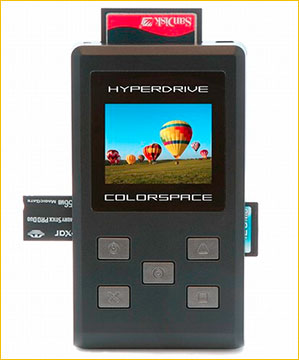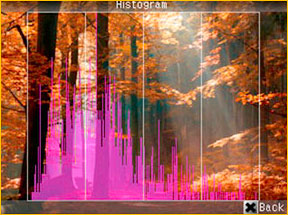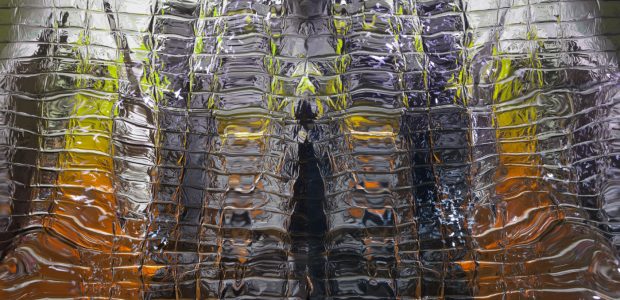
Product and Screen Shots Courtesy Sanho
No, it won’t take you to the next galaxy at Warp 9. But it will back up your camera’s card files in the field, quickly and reliably. And yes, I know, there are scads of such devices available. You may even already have a favourite. But whether you’re considering your first one, or a replacement or upgrade, theHyperdrive ColorSPACEis definitely worth your consideration. I have surveyed just about all of the devices currently available (December, 2007) and spoke with quite a few photographers who own different ones, and to my mind the Hyperdrive is the current king of the hill. Here’s why.
____________________________________________________________________
Doing The Job
Before considering any photographic device the first thing to ask yourself is –what are my real needs? In this case the need is to copy files from memory cards while in the field, and to do so quickly and securely.
The Hyperdrive is a device that is intended to work as a stand alone, but it can complement a portable computer and accessory hard drives as well. Let’s see what it does, how it works, and what problems it solves.
Rather than think of the Hyperdrive as just areader / driveI prefer to regard it as a portable 250 GB drive with a build in review screen and card reader. The difference is subtle but real. I travel with a laptop most of the time. This means that I need portable drives (usually at least 250 GB of redundant storage (two copies of everything). With the Hyperdrive I have one of those two drives, but also the convenience of having that drive battery operated, or stand-alone with a colour screen. There’s more, but we’ll get to that in a minute.
On the other hand, there are times that a laptop isn’t possible. A 10 day rafting trip down the Colorado River, a bicycle tour, a mountain trek – anywhere that there’s no electricity, or the need for very light weight over a period of days or weeks places constraints on what can be carried.
With the Hyperdrive (and other similar products) both needs can be met; a high capacity drive for use with a laptop and a stand-alone reader / drive when ultimate portability is what’s needed.
____________________________________________________________________
Hyperdrive
The Hyperdrive ColorSPACE is in fact a family of products, availablewith or without hard drive. If ordered with built-in drive, sizes of 40Gb to 250GB are available. The unit that I purchased was the top-of-the-line 250GB model, and it sells for US $459.
The screen is a 2.2 inch TFT with 320 X 240 pixel resolution. While not large by contemporary standards, it is sufficiently large for operation and navigation as well as image review.

The main screen upon start-up mirrors the five mechanical push buttons located beneath it. Each button has a unique symbol, and when there is a choice of button to be made the symbol is used to ensure that you select the correct one. Nicely designed and unambiguous.
Operation couldn’t be simpler. Put a card in its appropriate slot (CF, MD, SD, MMC, MS, MS Pro and Pro / Duo are supported) and press the Backup button. That’s it. The card is copied with verification and the copying process is displayed onscreen along with thumbnails of the images as they are being copied.

Any type of image file can be copied, and surprisingly the Hyperdrive appears to be able to display almost every raw file format that I threw at it, including the brand new Nikon D300 and Canon 1Ds MKIII. The only raw format that I had available for testing that it did not appear to recognize is that of the Phase One P45+ back. The files copied perfectly, but no preview was available.
I was also pleased to note that the Hyperdrive is able to detect the brand and type of card inserted and the user can optimize transfer rates for the particular technology of the card in use. With the fastest cards, such as Sandisk Extreme IV CF cards, one can expect as much as 25 MB/S, which translates to about a Gigabyte per minute. This is about the same as the unit’s USB 2.0 transfer speed.
I also greatly appreciated that the device seemed to always keep me informed of what it was doing, something that can’t be said for others that I have tried over the years. This includes the ability for the user to select the type of copy verification (including bit for bit comparison) and also whether to display the image coming off the card, or the one that has just been written to the drive. Very cool.
The Hyperdrive is able to browse a memory card without copying it. Ever wonder while in the field whether or not a card can be reused? Just pop it into the Hyperdrive and browse it. I was also pleased to notice that when browsing cards the built in hard drive shuts down, saving power. Nicely done.

Browsing can also be done, of course, to files that are on the drive and they can be displayed in a number of different way, including multiple thumbnails, at 100%, and with EXIF data as well as a histogram.

I was particularly impressed with the Hyperdrive’sSearchfunction which allows one to specify a year, month, and day and then automatically visually browse either a card or the unit’s hard drive for relevant images.
____________________________________________________________________
Power
The Hyperdrive is powered by a built-in and user replaceable generic 18650 Lithium Ion battery. The company claims that a charge is good for backing up 120GB of data. I have not yet had a chance to verify this, but my initial impression is that power management is very efficient, and battery life is likely to be very good.

A screwdriver is provided so that a replacement or new battery can be installed at any time, as can the hard drive, which is a standard configuration and easily accessible. (Any 2.5" IDE/PATA drive of any capacity can be used).
The unit comes with a small AC adapter / charger and it can also be powered and recharged via USB. In addition, an accessory 4 X AA battery pack is available for $9.95. This is the ticket for someone heading of into the great unknown, away from any source of electricity. A supply of double A batteries will be an emergency solution for the powerless.
Charging the internal battery takes about 2.5 hours on the AC adaptor and about 5 hours via USB. The Hyperdrive offers a very well thought-out power system. One of the best I’ve seen in such devices.
____________________________________________________________________
Driving About
Mac user should note that I had no problem with the Hyperdrive being powered and doing transfers from a single USB port, something that is not always the case with Macs. No double USB cable needed.
I also noted that when pluged in to USB the Hyperdrive isn’t automatically mounted. One has to press the USB activation button on the unit. This seemed strange until I realized that it made sense, because one might simply want to charge the unit via USB rather than transfer files to and fro. Curiously though, it took a full 40 seconds on a 13" Macbook for the drive to mount.
____________________________________________________________________
Card Recovery
Another surprise feature, and a real bonus in the field, is a built-in card recovery capability. I tested it by erasing a card in camera and then recovering all of the files in the Hyperdrive. This may not be as effective as some of the more efficient products such asImagerescue, but I know that a day will come when its availablity in the Hyperdrive will prove to be most welcome.
____________________________________________________________________
A Concern

There are two choices available on the device’s menu;Quick ScanandStandard Scan. These are handy for determining if a memory card has a problem. But I was concerned to see that Quick Scan is destructive. It will format the card, destroying any data. The Standard Scan is non-destructive, though it takes a very long time to perform its task.
This behaviour is mentioned in the accompanying documentation but it does create a potential pitfall for those who have not read the manual in detail.
____________________________________________________________________
The Bottom Line
When traveling and shooting on location, whether it’s around the town for the day or on the other side of the world for a month, image storage, transport and safety are paramount concerns. Some people prefer (or need to) travel light, while others bring with them as much as possible to cover every contingency. I used to be among the latter, but increasingly as I get older and as air travel become more restrictive I try and pare down my equipment to the bare essentials.
I still regard a laptop in the field as a necessity, and my 13" Macbook is small and light enough, yet powerful enough to do the job of coping with images in the field, both handling storage as well as initial image review in Lightroom.
But the computer’s hard drive is small, and so my files are always stored on portable hard drives; always two, which provides backup against head crashes, loss and theft.
Now, I have replaced one of my portable high capacity drives with the Hyperdrive. It does exactly the same job as a basic portable drive and is hardly much bigger and heavier. But it also has built in power, and a colour screen which adds to its versatility. When my work requires that I go off for a day or two’s shooting away from electricity I can travel with the Hyperdrive alone, copying cards to it for backup in the field.
Is the Hyperdrive ColorSPACE the best portable drive / card reader currently available? I don’t know, since I haven’t actually worked with everything else on the market. Yes, it’s more expensive than just a portable drive alone. But given its range of features and capabilities I find the extra cost to be well worthwhile and the unit itself a valuable addition to my travel kit. Highly recommended.
December, 2007
____________________________________________________________________
Update:
Canadian readers may be interested to know thatFilmPlusin Toronto has Hyperdrives in stock atpar pricingwith the US, though these are not yet listed on that company’s web site.
And for those of you in the UK,Digital Depotalso carries them.
You May Also Enjoy...
Dancing Beyond The Light : The new work of Sam Choisy
FacebookTweet Sam Choisy is a personal friend and an artist The Luminous Landscape profiled last year. Sam is a French transplant to Canada who carries

